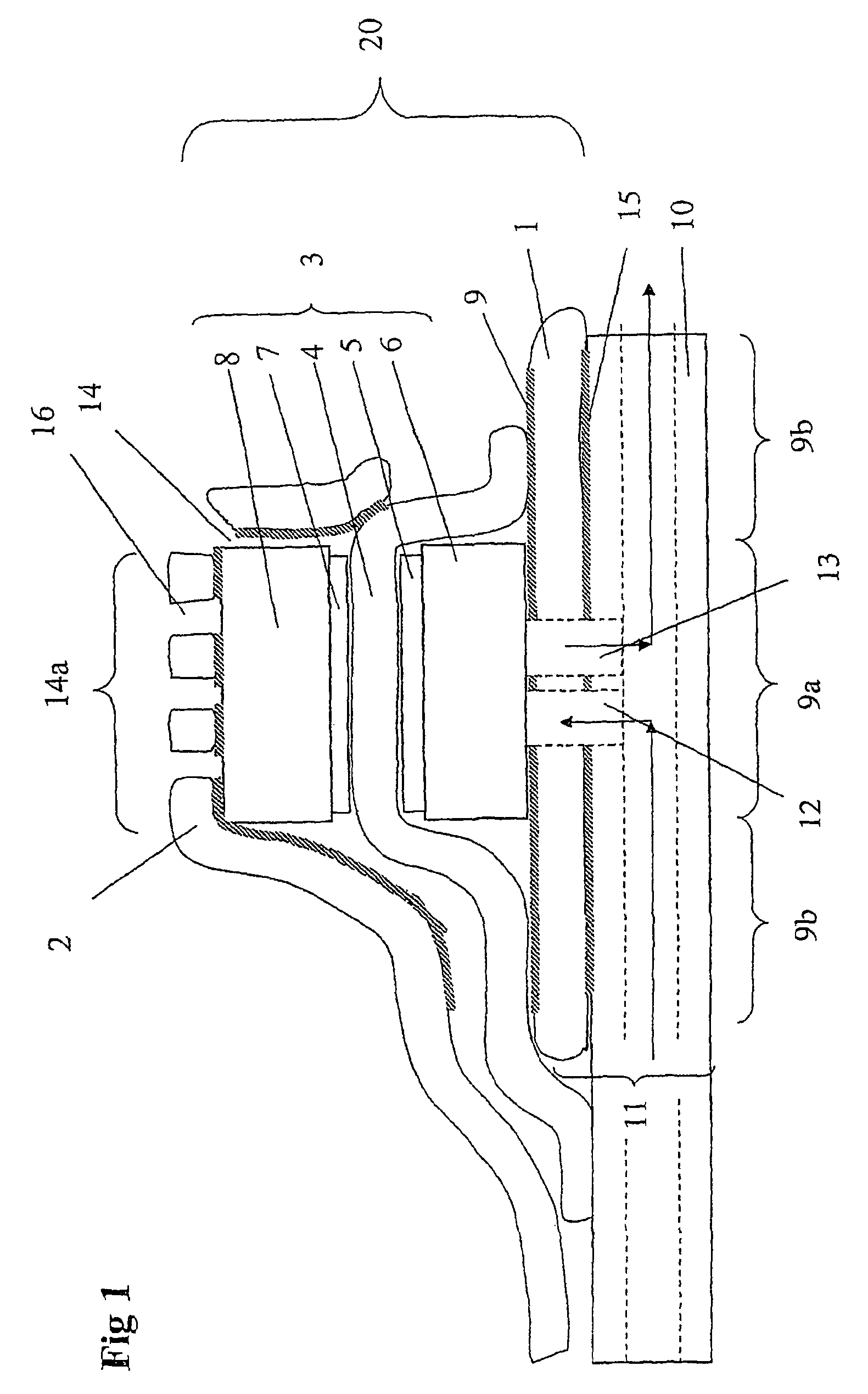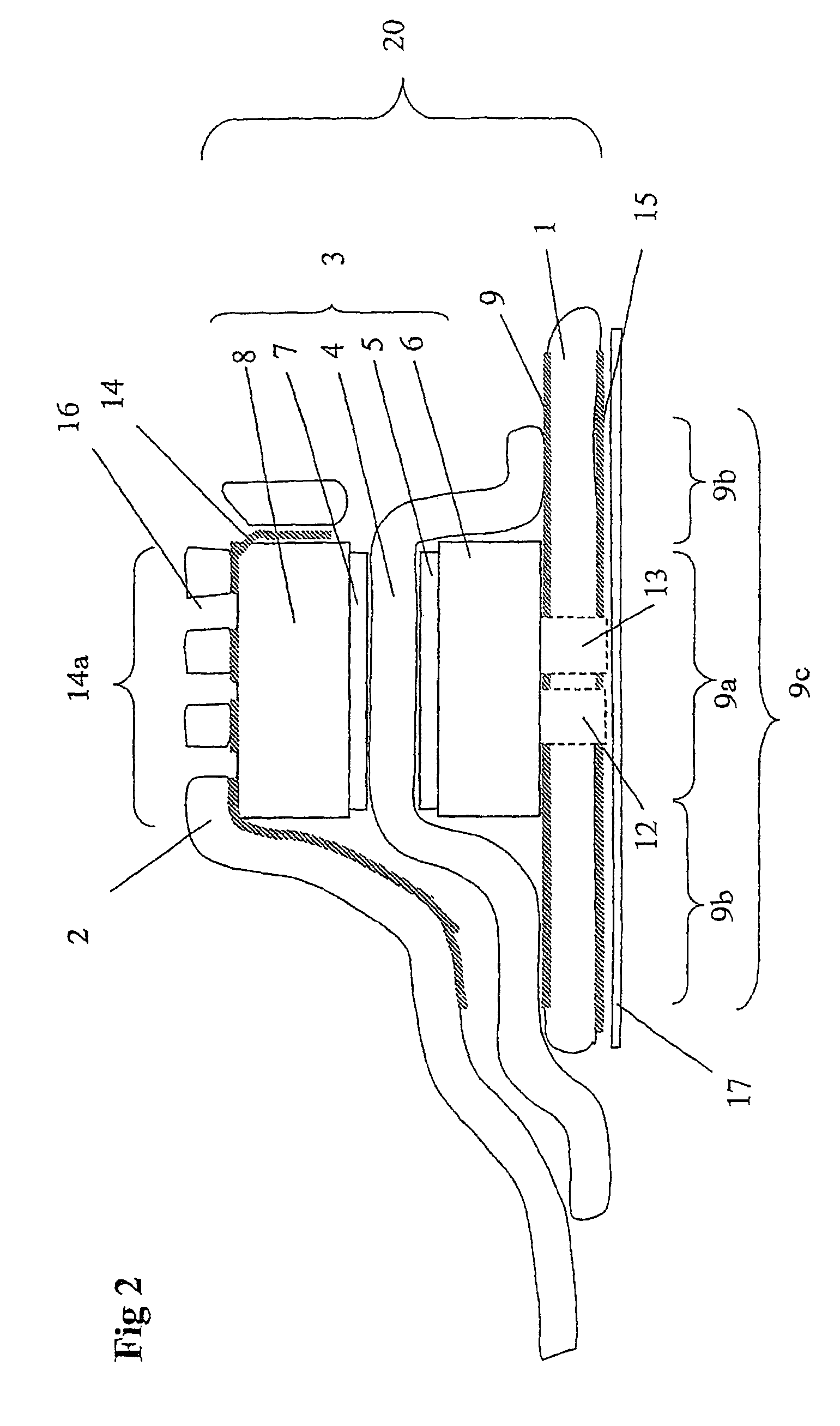Electrochemical device
a technology of electrochemical device and polymer electrolyte, which is applied in the direction of electrochemical generator, cell component details, cell components, etc., can solve the problems of low material cost, low stack output, and low stack efficiency, and achieves simple cathode current collector attachment and easy attachment to the support.
- Summary
- Abstract
- Description
- Claims
- Application Information
AI Technical Summary
Benefits of technology
Problems solved by technology
Method used
Image
Examples
example 1
[0051]FIGS. 5 and 6 show results for a single cell with the cathode current collector being a gold plated stainless steel net (15×15 mm). The clamping means (and current collector) was cut out from a plain Printed Circuit Board (PCB). The PCB was a commercial epoxy-glass composite uniformly plated with a 30 μm thick copper layer on one side. The Membrane Electrode Assemblies (MEAs) were Primea 5510 from Gore (0.3 mg Pt cm−2, 25 μm thick membrane). Gas backings were Carbel products from Gore, with their hydrophobic side turned against the MEA. The anode current collector was made of a copper foil having an electron-conductive adhesive film on one side. The supplier was TESA (product No. 4384). The adhesive was based on a silver-filled acrylic substance. The thickness of the adhesive film and copper foil was about 5 and 70 μm, respectively. The anode current collector was supported by the cell house, a 5 mm-thick Plexiglas sheet wherein gas channels were milled. The arrangement of the...
example 2
No Clamping Force
[0054]In another example a cell was assembled and tested where no clamping force was applied. The components were similar to what had been used in the previously mentioned cells except for the cathode current collector steel net and the PCB board. Instead as a cathode current collector a perforated conductive tape (a copper foil having an electron-conductive adhesive film on one side) was used. Before assembling the cell the MEA and the gas backings were integrated with each other into one unit by hot pressing at 110° C. The integrated gas backing and MEA was attached and sealed to the anode current collector. The MEA was made so large so that a good seal was formed and so that the anode and cathode current collectors did not short cut with each other. Finally, the cathode current collector conductive tape was connected to the cathode gas backing. The active cell area was about 2 cm2. During electrochemical cell testing with pure hydrogen it provided 500 mA at a cel...
example 3
[0055]In this example the cell area and the current collector materials were the same as in example 2. The electrodes were ELAT-electrodes (ETEK), which includes both a gas backing layer and an electrochemically active layer, with a Platinum loading of 0.5 mg / cm2. The membrane was Nafion 1035 Dupont). The membrane electrode assembly was formed by hot pressing at 110° C. Prior to hot pressing the membrane was pre-treated by boiling in 3% H2O2 for 1 hour, boiling in H2SO4 for 1 hour, and finally, two times boiling in pure H2O for 1 hour. The electrochemical testing was conducted with pure hydrogen and the results are given in Table 1.
[0056]
TABLE 1E (mV)I (mA)820060013500203503319044
PUM
| Property | Measurement | Unit |
|---|---|---|
| power | aaaaa | aaaaa |
| current densities | aaaaa | aaaaa |
| thick | aaaaa | aaaaa |
Abstract
Description
Claims
Application Information
 Login to View More
Login to View More - R&D
- Intellectual Property
- Life Sciences
- Materials
- Tech Scout
- Unparalleled Data Quality
- Higher Quality Content
- 60% Fewer Hallucinations
Browse by: Latest US Patents, China's latest patents, Technical Efficacy Thesaurus, Application Domain, Technology Topic, Popular Technical Reports.
© 2025 PatSnap. All rights reserved.Legal|Privacy policy|Modern Slavery Act Transparency Statement|Sitemap|About US| Contact US: help@patsnap.com



